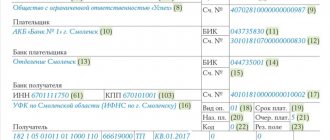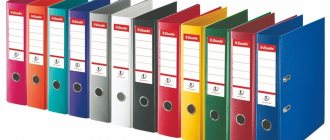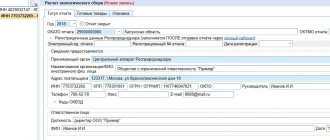The procedure for filling out the TTN and the rules must be followed in full, since this is an important document for accounting. It also helps to assert one’s rights when misunderstandings arise between participants in the process of moving property from one point to another. You don't have to go to court to do this. All issues can be resolved out of court. But for this you will have to document all the facts of economic life. This is a legal requirement regarding accounting, the fulfillment of which is subject to tax audit.
When to draw up a TTN
Its registration occurs during the transportation of goods and materials from one owner to another. The delivery itself is carried out independently by the sending company or with the assistance of the carrier company (third party). The one who sends the cargo also issues a waybill (its original owner for the alienation of the right or one of the divisions of the owner company to another). When using commercial transportation services, a contract for them can be drawn up by the sender or the recipient. Then the document under discussion can be signed by one or the other party.
TTN or TORG – 12
The first allows you to move property from one point to another. This paper is used to write off the goods from the shipper's balance sheet to the account of the new owner. The key point is the presence of a vehicle in this scheme. This action may not take place in the form of a transaction between two parties, but as a transfer of goods and materials between branches of one organization.
TN (the second of those presented) is necessary specifically when making a sale and transferring ownership of property. It doesn’t matter whether transport is involved here or not.
Procedure, rules for filling out the TTN and sample
For experienced specialists, its preparation is not difficult, since the form with the values is ready for registration. You just need to know what to enter and where.
Step-by-step instructions:
- First, we assign a number to the document and indicate it (using the internal numbering accepted at the enterprise), and enter the date.
- In the “shipper” line we write information about the company sending the goods and materials (with full name, geolocation and working phone number).
- By analogy, we write down information about the addressee in the “consignee” section.
- Where the word “payer” appears, you must enter the company paying for transportation services.
- The correct OKPO codes must be written next to all parties to the transaction.
The price and value of the goods are indicated in the TTN with VAT
The TTN form does not have a separate column for indicating the amount of VAT. How to fill out the columns “Price” and “Amount”: with or without VAT?
These columns indicate the amounts including VAT. And that's why. Under the contract of carriage, the carrier undertakes to deliver the cargo entrusted to him to the destination and deliver it to the consignee (Article 8 of the Charter; Article 785 of the Civil Code of the Russian Federation). The carrier is responsible for the safety of the cargo from the moment it is accepted for transportation until the moment it is delivered to the consignee and is obliged to compensate it in the event of damage (Article 34 of the Charter; Article 796 of the Civil Code of the Russian Federation). The TTN serves as the basis for settlements between the customer of the vehicle and the transport company. If something happens to the goods during transportation (for example, partially or completely breaks, breaks, gets lost), then you will be compensated for losses based on the cost indicated in the consignment note, that is, including VAT.
Bill of lading form
It can be unified, that is, uniform for use. You can use a format that is standard for everyone in order to certainly avoid claims from the tax authorities for arbitrariness in maintaining documentation. All information fits on one A4 sheet with compact placement of information and horizontal arrangement. The codes used here can be viewed in the all-Russian classifier.
When using a specialized program, the document is generated automatically if all the data is entered correctly. But today it is allowed to develop a convenient form yourself, shortening it, which greatly facilitates the work.
How to fill out a waybill (Bill of Lading) - rules, sample
Since this is an accounting document, the rules for its execution should be followed. It will necessarily be involved in accounting if it certifies the real fact of the economic life of the enterprise. You cannot underwrite information in the required cells, make simple blots on top of the finished version, present information here inaccurately, etc. Corrections must be certified with the date they were made. Responsible persons sign and leave their full names here. Primary documentation is allowed to be compiled on paper or stored in the form of an electronic copy. But since we are talking about an accompanying document here, it is done exclusively in paper version. It will have to be delivered to the agreed addresses and signatures collected.
Despite the permission not to use a unified format, there is definitely structure in the TT consignment note. Everything needs to be presented clearly and informatively. When starting a business, you can take common examples from the public domain. But in the future it is recommended to debug the work and use standard forms. Specialized programs will help in compilation.
Do you want to implement “Store 15”? Get all the necessary information from a specialist.
Thank you!
Thank you, your application has been accepted.
How to correctly draw up a TTN according to the sample
If a standardized form is used, then its execution will not be difficult for experienced employees. However, the state at one time allowed not to use previously developed formats of primary documents. Enterprises as economic entities can develop them themselves. Transporting organizations and customers constantly deal with these invoices. This somewhat complicates the work process for subsequent participants.
The standard assumes the design of several sections. If the tax office finds fault with incorrectly completed documentation and issues a fine, its amount will vary depending on the category of the offense. In addition, the responsibility of the authorized person is assessed lower and in case of shortcomings, fines come to his name in a smaller amount than for the whole company. It is necessary to assign control functions to the chief accountant. And provide it with good software on your computer. The same goes for warehouse workers. Automation of work will simplify the process of its execution and minimize errors. Often problems arise precisely when filling out the 2nd transport section of the TTN.
How is it different from TN?
The concept of TORG-12 was mentioned above. This is a form of T-waybill (namely “commodity bill”). It is standardized at the state level. There are also columns and rows with values that should be filled in. Private information about participants is provided and nationwide coding is used.
A TT invoice is issued if transport is used for delivery (with its full description), but with the above one you can do without it. The first one is allowed to be used when making sales and when simply moving cargo. And the second is required exclusively in the presence of commodity-money relations. It is more extensive and includes a lot of information (including terms of the transaction, quantity of goods and materials, cost, VAT).
In addition, there is another concept of TN (“transport”). Designed for road freight transportation.
For self-pickup, TTN is not needed
Our supplier does not have its own warehouse; we pick up the goods using our own transport from the warehouse of another organization - the shipper. Do we need a TTN to confirm expenses?
You purchase goods on a self-pickup basis and transport them using your own transport; there is no carrier, which means you do not need to issue a TTN. To confirm the fact of purchasing the goods and accepting it for registration, form N TORG-12 is sufficient. Recently, this position was supported by the Supreme Arbitration Court of the Russian Federation (Resolution of the Presidium of the Supreme Arbitration Court of the Russian Federation dated December 9, 2010 N 8835/10). The Ministry of Finance adheres to the same opinion (Letters of the Ministry of Finance of Russia dated January 31, 2011 N 03-03-06/1/42, dated June 15, 2010 N 03-03-06/1/413). Perhaps now, taking into account the position of the Supreme Arbitration Court of the Russian Federation and the opinion of the Ministry of Finance on this issue, tax authorities will not insist on issuing a TTN for self-pickup. And to confirm transportation costs, for example, to take into account the cost of gasoline, a waybill that justifies the trip is sufficient (Resolution of the Federal Antimonopoly Service VSO dated November 17, 2008 N A19-6488/08-50-F02-5714/08).
Who should issue a TT invoice?
Depending on the situation and stage, this is done by the recipient or the sender (and all their employees and representatives). Usually it is the sender who applies it to loading and then everyone is engaged in entering their data. The driver reports the route, and the recipient describes the acceptance procedure. A third party may be involved in the delivery (on contractual terms of cooperation). Then a transport company specializing in transportation is also related to TTN. Both parties have the right to enter into an agreement with it.
TTN for transit delivery
We do not have our own warehouse. The goods are shipped from the warehouse of our supplier, who delivers the goods directly to our buyer. The supplier (aka the shipper) writes out the TTN and fills out all the columns, including the product section with its sales prices. Upon receipt of the cargo, our buyer signs the TTN and receives a copy of it. We don't want our buyer to know our supplier and his prices. Is there a possibility to solve this problem?
Under such conditions, you will not be able to influence the filling of the TTN. The columns “Price” and “Amount” must be filled in by the supplier. It is unlikely that you will be able to persuade him to leave these columns empty, since in the event of unforeseen circumstances he will not be able to recover damages from the transport company. And he is also unlikely to agree to indicate your sales prices in the TTN.
Document structure
In addition to the unified form, where the structure is clearly visible, there are special instructions on the procedure for payment for transportation from 1983 onwards. The last revision was in 1997. It accurately describes the filling instructions in a step-by-step manner. In total, there are 16 rule blocks with their own number of columns and paragraphs on the topic of correct documentation.
Since the beginning of 2011 (Federal Law 402), the format of such an accounting “primary” has been approved by the economic entity. However, it must contain all the necessary details (as specified in the same Federal Law). Therefore, now unified all-Russian forms do not need to be used, but rather develop your own with the required points. But to avoid mistakes, a ready-made basis for filling is also good. The main thing is that a single rule applies to all situations: an invoice must be drawn up when a fact of economic life is completed, and if this is not possible, immediately after its completion. In general, all participants need to understand the structural arrangement of blocks. It is also necessary to take into account how to correctly fill out and sign the TTN for the driver.
Consignment note 2021: sample filling
In 2021, the form of the waybill has changed. Since December 22, a new edition of the rules for transporting goods by road has been in force (Government Decree No. 1529 dated December 12, 2020). They now regulate the transport of goods by heavy or large vehicles (and not the transport of heavy or large goods, as before). Along with the rules, the forms of the relevant documents have also been updated.
- Confirms the conclusion of a cargo transportation contract.
- Confirms the legality of transportation.
- Includes only the transport section. It contains information about the carrier, shipper, recipient, transportation conditions, as well as data confirming the fact of cargo transportation and the costs of it.
- Includes information about the containers used for cargo transportation, the packaging method, labeling, and cargo items: their weight, volume, dimensions. TTN does not have this information.
- Includes instructions from the shipper about the required parameters of the vehicle, data on transportation conditions, the actual condition of the cargo, seals, containers and packaging, reservations and comments from the carrier. This information is not indicated in the TTN.
- Does not include telephone numbers of legal entities (senders, recipients, carriers), but contains numbers of persons responsible for transportation.
- Does not require signatures of officials who authorized the release of cargo and persons who released the cargo. Also, the signature of an accountant, chief or senior is not required. The TTN must contain all these signatures - in the product section.
- It does not include information about the payer - name, address, bank details - unlike the TTN.
- Serves as the basis for payments for the transportation of goods by road.
- Confirms the costs of road transportation.
- It cannot serve as a basis for the receipt of inventory items by the buyer and for their write-off by the supplier. The TN does not contain a section with the necessary information: the price per unit of goods and the total cost of all transported goods are not given. You can only indicate the declared value of the cargo. Then, in the event of a shortage or damage to the goods due to the fault of the carrier, it will be possible to calculate the amount of compensation.
- Filled out in triplicate. Instructions for issuing a consignment note, an example of filling out and a blank form for 2020 are below.
We recommend reading: Application for a family emergency from a teacher
Filling algorithm
The document must indicate the carrier, the consignee, the name of the procedure (for example, shipment of a specific product or, conversely, loading) with the date, as well as the type of product being shipped/loaded.
Filling out the 1st section in 1-T
Almost all of it will be filled out by the shipper. To begin with, detailed information about the property being moved, food products, etc. is entered into the table.
The first column contains the item number of the goods and materials. In the second and third - the price list number with the article (if such types of accounting are fundamentally maintained in this organization). In the fourth, with the value “Quantity”, the number of transported items, products, etc. is entered. Next comes information about the piece price, exact names, measuring units, type of packaging (cardboard, cellophane materials, etc.)
Further, in the order of registration and filling out the consignment note (Bill of Lading), different digital values are written about places, tonnage and cost. If you overpay for something (excess weight, transportation costs), this is also indicated.
The next step is to enter the generalized amount for all categories and product numbers according to the warehouse system. Then the weight of the cargo is written in words and in digital terms, the appendices (with the number of sheets) are indicated and below in words the full and final price of the released warehouse property.
Below on the left side you need to sign the responsible persons with transcripts: the shipper, the authorized person for release with shipment, as well as the chief accountant. To the right, enter the driver’s data (about his identity, existing power of attorney). A little later, the person representing the consignee will sign here to confirm that the “parcel” has been received.
Completing section 2
Here we insert transportation information.
Namely:
- when will the cargo be delivered?
- describe the carrier company;
- enter information about the car (make and state number);
- in the far right column - the numbering of the invoice and waybill.
In the “Payer” section we include information about the delivery customer and the driver. Next, you need to make it clear that this is a license card, a registration number in the TTN and what to write about the series in the transport section. You only have this information when you undergo licensing a little earlier. It is not currently being carried out, so this information may seem unclear to you. It is simply missing and missed. As for the type of transportation, it is necessary to clarify - “commercial”. As for waypoints, they can be adjusted in the future.
Below is a sign. In the column “Method of determining mass” the measurement method is indicated (what weighing devices were used: manual, automatic and other formats). To the right under the table are other accompanying documents: confirming quality, passports, acts, etc., and to the left are signatures. Next comes the table image again. Here we write information about loading/unloading.
If several sheets are expected, then additional ones must be mentioned. Moreover, on subsequent pages the number of inventory items and locations involved is duplicated. The driver also enters information: mileage, travel costs, penalties for incorrectly executed documents, downtime, etc. At the end, the carrier’s accountant writes out the calculation.
What should I write about the method of determining the weight in the TTN according to the rules for issuing a consignment note if this weighing did not take place? If there is none, we indicate “normative” or “according to the labeling”.
Who signs the document?
All actors involved in issuing from the warehouse, loading, unloading, delivery and acceptance of goods and materials. They are financially responsible to their management or customer. And they have documented authority to sign the accounting documentation. In the absence of these, the paper may be invalidated. But this will happen during trials. Otherwise, the error will go unnoticed.
Where is the stamp placed?
On all documents it is affixed in the part where there is an indication of positions. The people occupying them must sign. As for non-standard forms, the location of the desired location may move. In any case, it is located after all the information about the participants and the goods being moved. By signing, persons certify dispatch, transportation and acceptance. The location in the unified version is in the middle part of the sheet. To be sure, it’s better to see how to make and issue a consignment note according to the sample.
Applications
Additional documents can be attached to Form 1-T if they are required in a particular situation. These are passports, certificates, various certificates and contracts. Their list should be indicated in the line provided. Or they will not be taken into account. Failure to comply with formalities causes additional difficulties. You will have to deliver the papers or send them by mail. All papers are also required to be stamped and signed. The information contained in them should not contradict each other.
How to issue a waybill
A bill of lading is a document confirming the conclusion of a transportation agreement: in a situation where the goods are delivered by an engaged carrier. The PPT.ru material contains a sample of filling out a bill of lading, the procedure for filling it out and the requirements for filling it out.
ConsultantPlus FREE for 3 days
Get access
Since 2011, new Rules for freight transport by road have been in force on the territory of the Russian Federation, which were approved by the Decree of the Government of the Russian Federation dated April 15, 2011.
No. 272 “On approval of the Rules for the transportation of goods by road” (hereinafter referred to as Rules No. 272). This document (Appendix 4) also approved the form of the consignment note and the rules for filling it out.
Let's look at an example of how to use them.
In what cases do we issue and in what cases do we not issue a waybill?
You need to fill out an invoice:
- in a situation where the goods are delivered precisely by the contracted carrier on the basis of a contract of carriage;
- if the goods are delivered by a forwarder and an agreement and the forwarder is required to enter into a transportation agreement (the forwarder acts as the sender).
If the contract is not concluded and the buyer removes the goods from the sender’s warehouse using his own transport, then transportation services are not provided and the invoice is not drawn up.
Requirements for filling
The sample for filling out the new 2019 bill of lading must take into account the requirements of Regulation No. 272.
- The consignment note is a document confirming the conclusion of a transportation agreement (clause 6 of Rules No. 272).
- Unless otherwise provided by the contract of carriage, the invoice is drawn up for one or more consignments of goods transported on one vehicle.
- 3 copies (originals) of the waybill are drawn up for the shipper, consignee and carrier, they are signed by the shipper and carrier or their authorized persons (clause 9 of Rules No. 272).
- The consignment note, unless otherwise provided by the contract, is drawn up by the shipper (clause 6 of Rules No. 272). The sender can be both the supplier of goods and their buyer, persons authorized by the seller and buyer, as well as a forwarder.
- If corrections are made to the document, they must also be certified by the signatures of both the shipper and the carrier or their authorized persons (clause 9 of Rules No. 272).
- In the case of loading cargo to be transported onto various vehicles, a number of invoices should be drawn up that corresponds to the number of vehicles used (clause 10 of Rules No. 272).
Persons who sign the document must be authorized by valid powers of attorney or official duties.
The order of filling in sections
The form consists of 17 sections:
1. Provide information about the shipper: name, address, bank details, full name, location address, telephone number.
2. The same data is indicated, but about the consignee (we repeat: name, address, bank details, full name, location address, telephone number - see sample).
3. The name of the cargo being shipped, its condition and other necessary information about the cargo, the number of pieces and net or gross weight, dimensions are recorded.
4. The accompanying documents for the cargo are indicated. These can be documents of title, various certificates, passports, certificates, permits, etc. For example, as shown in the sample, a delivery note and quality certificates.
5. If necessary, special requirements for cargo transportation are included: parameters of the vehicle, information about locking and sealing devices, declared value (value) of the cargo, required temperature, volume, etc.
6. Information about acceptance of cargo for loading (address, date, time, weight, quantity, actual condition - see sample). The signatures of the driver and the shipper are affixed with a transcript of the signature and an indication of the position.
7. Information about the delivery of cargo for unloading (address, date, time, weight, quantity, actual condition). The signatures of the driver and the consignee are affixed with a transcript of the signature and an indication of the position.
8. Conditions of transportation. Enter or select from those presented, special conditions of transportation or temporary warehousing, information about the penalties provided for in the contract of transportation.
9. Information about acceptance of the order (application) for execution is indicated.
10. Data about the carrier is entered: name and address of location, telephone number, full name and telephone number of the driver.
11. Information about the vehicle is entered: quantity, type, make, carrying capacity, registration numbers.
12. The carrier fills in data on the actual condition of the cargo, packaging during loading and shipment, and possible changes in transportation conditions during movement.
13. Other conditions are indicated if necessary: when transporting dangerous, temperature-sensitive, oversized cargo; The driver’s work and rest schedule along the route is recorded.
14. To be filled in if the place of delivery of the goods has changed.
15. The cost of cargo transportation services, the procedure for calculating and the amount of freight charges, and the carrier’s expenses presented to the shipper are reflected. The full name of the payer's organization (shipper), address, and bank details of the payer's organization (shipper) are also indicated.
16. The date of preparation and signatures of the parties (shipper and carrier) are indicated.
17. Here you can enter violations during cargo transportation and claims from the shipper, consignee, and carrier.
Who issues 1-T when transporting by road?
The original designer may change. This is the sending, receiving party or a third party. The latter is possible by concluding an agreement with the transporter. But a more common situation is when the goods are processed by the direct sender. He is allowed to order transportation from a third party or use his own driver.
If delivery is carried out by the supplier
This means that he gets the role of a filler. It will eventually reach all recipients, for which several copies are made at once. These are transferred to the regular driver or an employee of the transport company. Using the instructions, the correct filling of the TTN is guaranteed.
If the customer organized the removal
According to the rules, the person ordering transportation is the shipper (Government Decree 272 of April 11). This means that the functionality passes into his hands. Although it is worth clarifying what “order transportation” means. After all, it can be ordered by one or another subject of the transaction. By agreement, one or the other person also has the right to pay. Everything is negotiable.
If transporter services are ordered
He can be hired by any of the indicated persons and make payments to him in a jointly agreed upon way. That is, delivery can be made at the recipient’s expense (if agreed) or at the sender’s expense. The option of separating responsibilities is also acceptable. The amount is paid in installments from each payer or by one payer (with or without their subsequent offset). But the transporting organization most often does not issue the TTN itself. This is what the main participants do. However, redirection may occur along the route. Then the delivery person prescribes changes on the fly. The lines “Consignee” and “Unloading point” have been corrected. When an order is received by an intercity transport organization, the carrier can himself fill out form No. 2-tm in 5 copies and enter details in the header based on the application and waybill No. 4.
Is it necessary to issue a TTN when delivering cargo?
Meanwhile, the Rules establish that the waybill, unless otherwise provided by the contract for the carriage of goods, is drawn up in three copies (originals) - respectively for the shipper, consignee and carrier. In general, the shipper will only have a copy signed by the carrier. It confirms the conclusion of the contract of carriage (clause 20, article 2, clause 1, article 8 of Law No. 259-FZ). And the Rules do not provide for the obligation to return a copy signed by the consignee to the consignor.
At the same time, the Ministry of Finance of Russia in letter dated April 30, 2004 No. 04-02-05/1/33 explains: for the recognition of expenses under civil contracts, the act of services rendered is a mandatory supporting document only if its preparation is mandatory in in accordance with civil law or a concluded contract. But in the case of a contract of carriage, the law does not provide for the drawing up of an act. The delivery of the cargo, that is, the provision of the service, is confirmed by the consignee’s signature on the consignment note. This event will also determine the date the carrier issues an invoice.
Number of copies
There are 4 of them in total. Signatures are placed on the consignment note for everyone. The compiler keeps one for himself. The rest are given to the driver for subsequent transfer. The 2nd is given to the consignee, and the 3rd and 4th are given to the head of the transporting company. The last two should already be signed by the sender and the recipient. The penultimate one, together with the invoice for payment for the transportation service, is transferred to the customer. And the final amount goes to the carrier in his accounting.
Do you want to implement Warehouse 15? Get all the necessary information from a specialist.
Thank you!
Thank you, your application has been accepted!
New procedure for issuing a waybill
As a rule, enterprises pay little attention to accompanying documents when delivering goods.
Meanwhile, their correct completion is a necessary condition for recognizing expenses. Therefore, it is necessary to monitor changes in legislation in this area. After loading is completed, the carrier signs the bill of lading and, if necessary, indicates in section 12 “Reservations and comments of the carrier” of the bill of lading his comments and reservations when accepting the cargo. In this section of the waybill, the carrier (driver) also notes a change in the conditions of cargo transportation (clause 28 of Rules No. 272).
Do I need to return the document?
This is the same paper as the transfer acceptance certificate. They must be kept by both parties to the transaction with the signatures of their representatives. They are signed and returned as they are required for reporting and accounting purposes. And also to certify the actions taken, which will help to defend your rights if necessary. From the above it is clear that the TT invoice is formed in a large number of different variations. It is needed to describe the shipment and the persons involved. In the end, everyone gets their own copy, on which the rest of the characters had previously signed. This primary documentation goes to the archive, and until that moment remains under control in the accounting department.
We looked at what sections it consists of and how the waybill is filled out.
If the company has developed its own form, then it may be necessary to explain all its subtleties to other participants. After all, many still use the previously adopted standardized document for convenience and reliability. Software from Cleverence will help simplify all routine procedures with documents. We offer solutions of various types: both individual offers that are personalized specifically for the type of business activity and all the features of the “internal kitchen” of a legal entity, and packaged solutions for any company. Number of impressions: 23358
Ttn or waybill in 2020
Invoices are drawn up in four copies. In this case, the first copy with the driver’s signature confirming receipt of the cargo remains with the shipper. In case of loss or damage to the cargo in transit, according to this document, the sender of the cargo will be able to recover material damage from the transport organization carrying out the transportation of this consignment. After all, when signing the consignment note, responsibility for the safety of the cargo is transferred to the transport organization.
We recommend reading: Register in a house in SNT
The movement of goods and materials and payments for their delivery are taken into account using a consignment note (Bill of Lading). The document includes 2 sections: transport - for writing off and capitalizing valuables by the parties to the transaction, commodity - for settlements with the transport company for services rendered.








